Bundle > NRNP 6566 Week 3|NRNP 6566 Week 4|NRNP 6566 Week 5|NRNP 6566 Week 6|NRNP 6566 Week 7|NRNP 6566 Week 8|NRNP 6566 Week 9|NRNP 6566 Week 11|(BUNDLE)|NRNP 6566 Week 3,4,5,6,7,9 AND 11 Knowledge Check (100% Correct) Verified Answers
NRNP 6566 Week 3|NRNP 6566 Week 4|NRNP 6566 Week 5|NRNP 6566 Week 6|NRNP 6566 Week 7|NRNP 6566 Week 8|NRNP 6566 Week 9|NRNP 6566 Week 11|(BUNDLE)|NRNP 6566 Week 3,4,5,6,7,9 AND 11 Knowledge Check (100% Correct) Verified Answers
Mrs. Franklin is a 68-year-old woman with long-standing, persistent AF being managed with rhythm control on dofetilide. She also has type 2 diabetes mellitus (T2DM), hypertension, and a myocardial inf... arction 3 years ago. What is her CHADS2 and CHA2DS2-VASc score? How would you interpret those scores in deciding on treatment for Mrs. Franklin? Correct Answer: CHADS2 score=2 (HTN, T2DM) A score of greater than 2 is considered high risk for stroke. CHA2DS2-VASc score=5 (age >65, female, HTN, T2DM, coronary artery disease [CAD]) A score of greater than 2 is considered high risk for stroke. Many patients are hesitant to begin anticoagulation due to the expense and inconvenience. However, after understanding that a 4% annual risk for stroke (if the CHA2DS2-VASc Score is 4) equates to 40% risk over 10 years, patients are more willing to comply. A 58-year-old male complains of a galloping heart rate and shortness of breath. Vital signs are BP 110/74, P 156, RR 22 Oxygen sat is 96%. Continuous EKG monitoring identifies periods of sinus tachycardia as well as episodes of atrial fibrillation. Laboratory results for this patient show: Hemoglobin 13.3 g/dl Hematocrit 39% WBC 8.7 Platelets 172,000 Sodium 140 Potassium 3.7 TSH 0.0 mIU/L T4 3 mg/dl T3 6.6 pg/ml What is your working diagnosis and what two initial medications would you prescribe for this patient? Correct Answer: The low TSH combined with the high T4 and T3 are indicative of hyperthyroidism. A common side effect of the hypermetabolic state is atrial fibrillation. Two medications that should be considered for initial treatment are beta blockers and anti-thyroid drugs. Beta blockers offer quick relief symptoms of hyperthyroidism, such as tachycardia, palpitations, heat intolerance, and nervousness. Nonselective beta blockers, such as propranolol, are preferred because they have a more direct effect on hypermetabolism. Start propranolol at 10 to 20 mg every 6 hours and titrate upward until symptoms are controlled. Once the T4 and T3 have normalized, the propranolol can be tapered off. Methimazole is the drug of choice in nonpregnant patients because of its lower cost, longer half-life, and lower incidence of hematologic side effects. Start the medication at 15 to 30 mg per day. Monthly free T4 and T3 levels should be obtained and methimazole adjusted to reach an euthyroid state. Maintenance doses may be lower (5–10 mg daily). A 63-year-old female has been successfully cardioverted and is now on amiodarone for rhythm maintenance. The patient is on the following medications: Warfarin 10 mg po daily Lisinopril 20 mg po daily Amiodarone 400 mg po daily Prilosec 20 mg po daily Digoxin 4250 mcg po daily What interactions are possible and how would you monitor and adjust for them. Correct Answer: Amiodarone is known to interact with warfarin and digoxin. Digoxin levels may increase 30–50% when taken with amiodarone. Amiodarone increases digoxin concentrations by inhibiting the P-glycoprotein (P-gp) mediated transport that facilitates the elimination of digoxin from the body. The greater the concentration of amiodarone the greater the increase in serum digoxin levels. Patient’s digoxin levels should be closely monitored, and dosing should be decreased to account for this effect. Amiodarone is a potent inhibitor of the enzymes that metabolize warfarin. Decreased metabolism of warfarin leads to higher plasma concentration levels and increased risk of bleeding. Warfarin doses should be decreased, and frequent INR monitoring is indicated when initiating amiodarone treatment. What is your interpretation of this 12-lead EKG? Correct Answer: Extensive anterior MI (“tombstoning” pattern) Massive ST elevation with “tombstone” morphology is present throughout the precordial (V1-6) and high lateral leads (I, aVL). This pattern is seen in proximal LAD occlusion and indicates a large territory infarction with a poor LV ejection fraction and high likelihood of cardiogenic shock and death. A 62-year-old male develops acute atrial tachycardia with a heart rate of 155. BP has been stable at 122/ 86. He is alert and oriented with adequate urine output. What medication would be utilized to treat the heart rate? Correct Answer: Beta blockers, such as Inderal or esmolol, would block conduction of atrial impulses through the AV node. Non-dihydropyridine calcium channel blockers, such as diltiazem or verapamil, would also be appropriate choices. Mrs. Franklin is a 68-year-old woman with long-standing, persistent AF being managed with rhythm control on dofetilide. She also has type 2 diabetes mellitus (T2DM), hypertension, and a myocardial infarction 3 years ago. She also takes an 81 mg aspirin every day. Based on her CHADS2 score and HAS-BLED score, would you recommend starting her on anticoagulation? What data would help you explain why this is important preventative step for the patient? Correct Answer: The decision regarding use of oral anticoagulation should always involve careful consideration of the risks and benefits, and the patient should be involved in that decision. It is suggested to calculate both a patient’s risk of stroke and risk of bleeding and use these data to communicate your reasons for suggesting your recommended therapy. Consider using a HAS-BLED score as a tool to potentially guide the decision to start anticoagulation in patients with atrial fibrillation. Compare the risk for major bleeding (HAS-BLED) to the risk for thromboembolic events (CHADS2 or CHA2DS2-VAS) to determine the benefit of anticoagulation. For example: The patient, having paroxysmal AF with your current risk factors for stroke puts you at a 6.7% risk of stroke per year. At this risk, you would benefit from oral anticoagulation (warfarin, dabigatran, rivaroxaban), which would reduce your risk of stroke by approximately 66% or decrease your risk from 6.7% to approximately 2.2% per year. Your risk of major bleeding (intracranial hemorrhage, hospitalization for bleeding, drop in hemoglobin by 2 g/dL, or requiring a blood transfusion) while on oral anticoagulation is 5.8%, which is lower than your risk of stroke without treatment. We generally recommend oral anticoagulation when an individual’s risk of stroke exceeds the risk of bleeding. What is your interpretation of this 12-lead EKG? Correct Answer: Acute Anteroseptal STEMI ST elevation is maximal in the anteroseptal leads (V1-4). Q waves are present in the septal leads (V1-2). There is also some subtle STE in I, aVL and V5, with reciprocal ST depression in lead III. A 59-year-old male complains of dizziness, palpitati [Show More]
Last updated: 2 years ago
Bundle contains 9 items
This Bundle Contains 9 Items
*NURSING> QUESTIONS & ANSWERS > NRNP 6566 Week 3 Knowledge Check (100% Correct) Verified Answers (All)
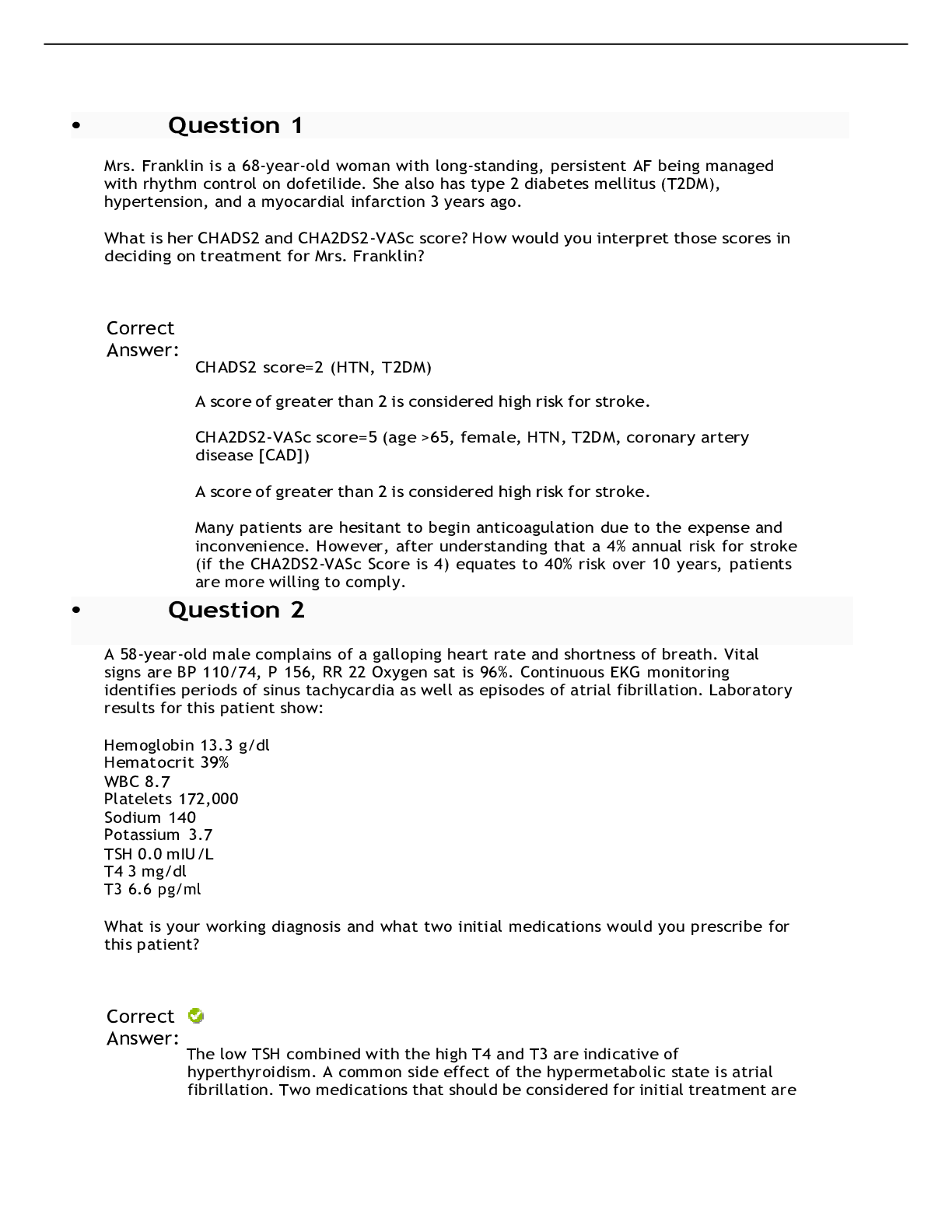
NRNP 6566 Week 3 Knowledge Check (100% Correct) Verified Answers
Mrs. Franklin is a 68-year-old woman with long-standing, persistent AF being managed with rhythm control on dofetilide. She also has type 2 diabetes mellitus (T2DM), hypertension, and a myocardial inf...
By Nutmegs
QUESTIONS & ANSWERS
$7
0
*NURSING> QUESTIONS & ANSWERS > NRNP 6566 Week 4 Knowledge Check (100% Correct) Verified Answers (All)
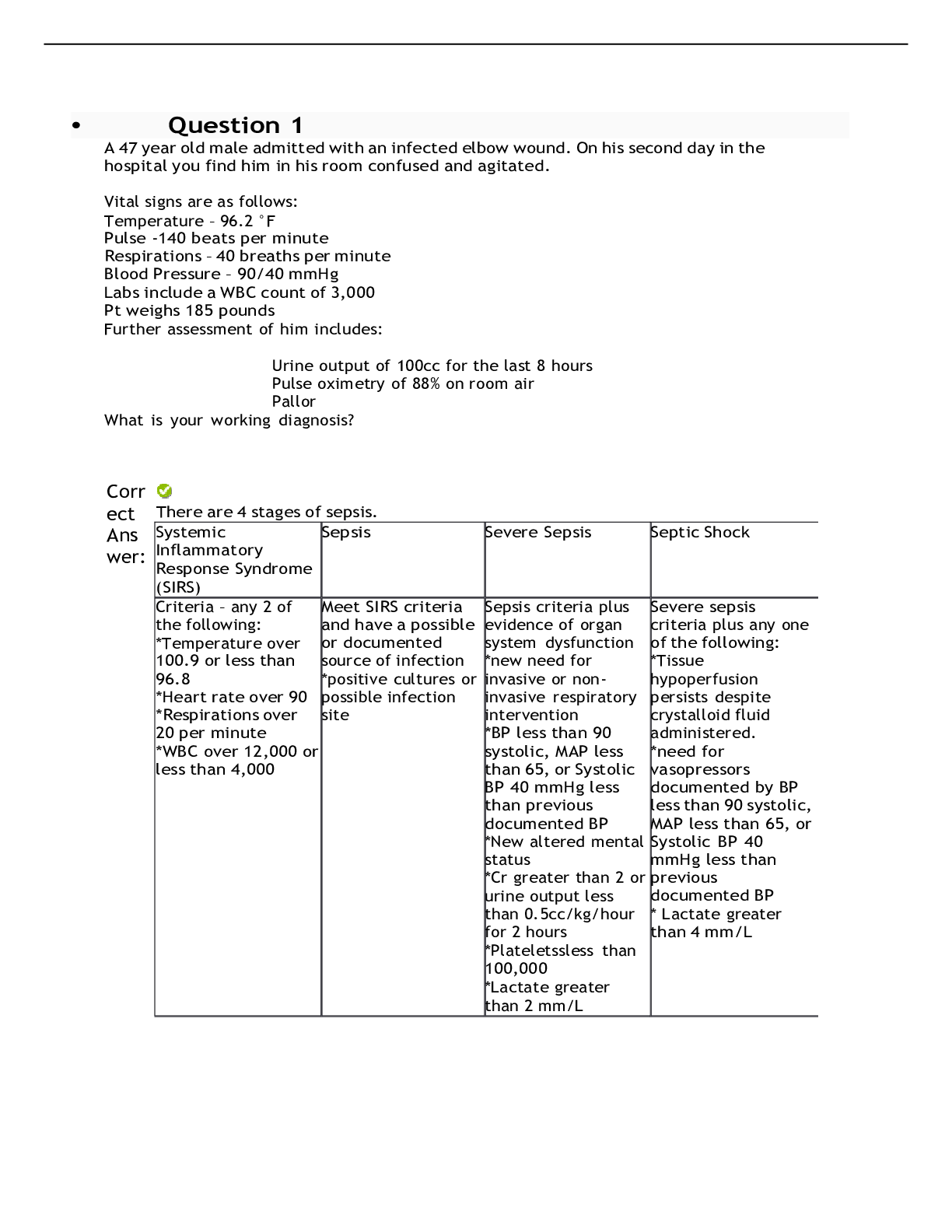
NRNP 6566 Week 4 Knowledge Check (100% Correct) Verified Answers
A 47 year old male admitted with an infected elbow wound. On his second day in the hospital you find him in his room confused and agitated. Vital signs are as follows: Temperature – 96.2 °F Pulse...
By Nutmegs
QUESTIONS & ANSWERS
$7
0
*NURSING> QUESTIONS & ANSWERS > NRNP 6566 Week 5 Knowledge Check (100% Correct) Verified Answers (All)
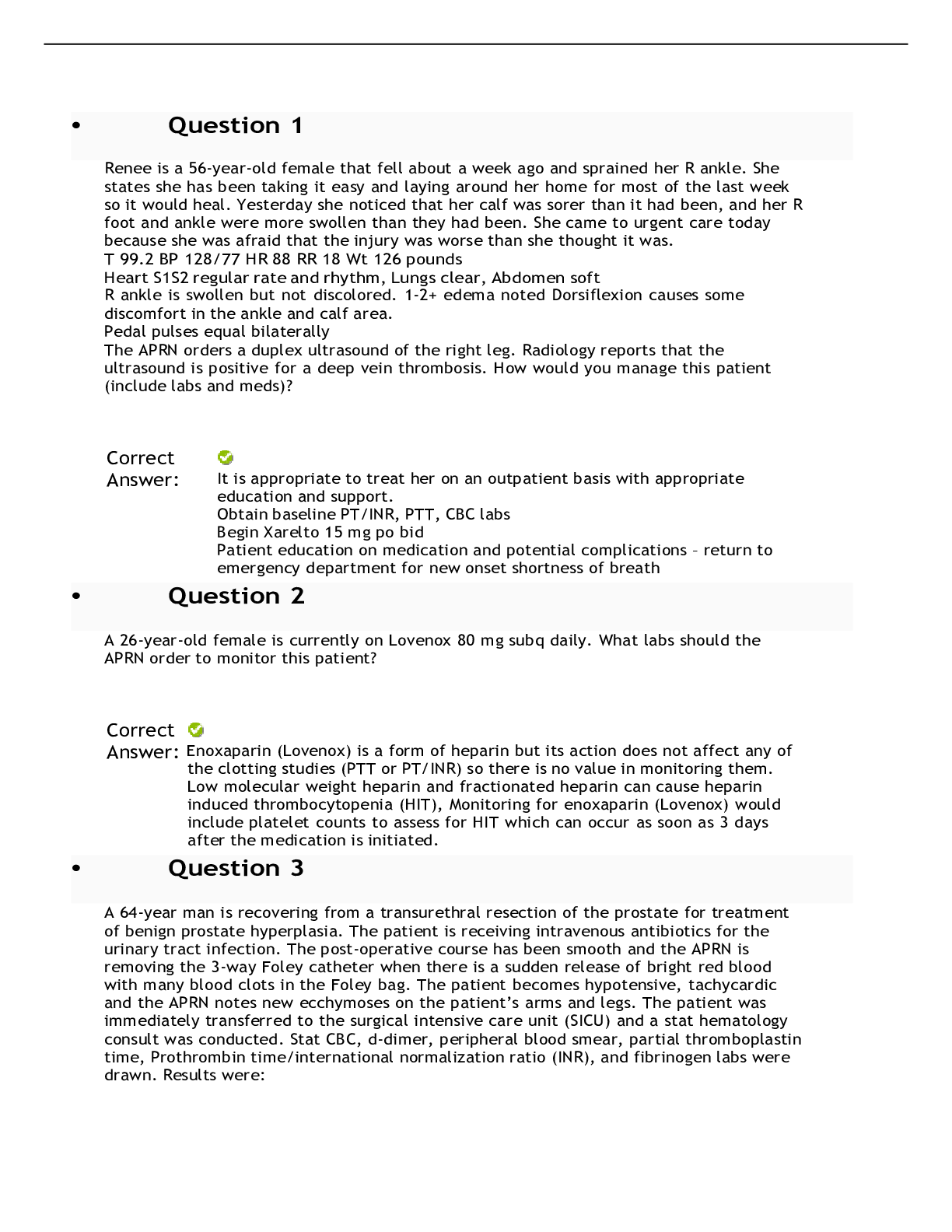
NRNP 6566 Week 5 Knowledge Check (100% Correct) Verified Answers
Renee is a 56-year-old female that fell about a week ago and sprained her R ankle. She states she has been taking it easy and laying around her home for most of the last week so it would heal. Yesterd...
By Nutmegs
QUESTIONS & ANSWERS
$8
0
*NURSING> QUESTIONS & ANSWERS > NRNP 6566 Week 6 Knowledge Check (100% Correct) Verified Answers (All)

NRNP 6566 Week 6 Knowledge Check (100% Correct) Verified Answers
A 54 year old female has a 30 year pack smoking history. She recently underwent pulmonary function testing which showed moderate obstructive lung disease. What would your treatment plan (including med...
By Nutmegs
QUESTIONS & ANSWERS
$7
0
*NURSING> QUESTIONS & ANSWERS > NRNP 6566 Week 7 Knowledge Check (100% Correct) Verified Answers (All)

NRNP 6566 Week 7 Knowledge Check (100% Correct) Verified Answers
A patient with respiratory failure has hemodynamic monitoring and is receiving mechanical ventilation with peak end-expiratory pressure (PEEP) of 10 cm H2O. Which information indicates that a change i...
By Nutmegs
QUESTIONS & ANSWERS
$7
0
*NURSING> QUESTIONS & ANSWERS > NRNP 6566 Week 8 Knowledge Check (100% Correct) Verified Answers (All)
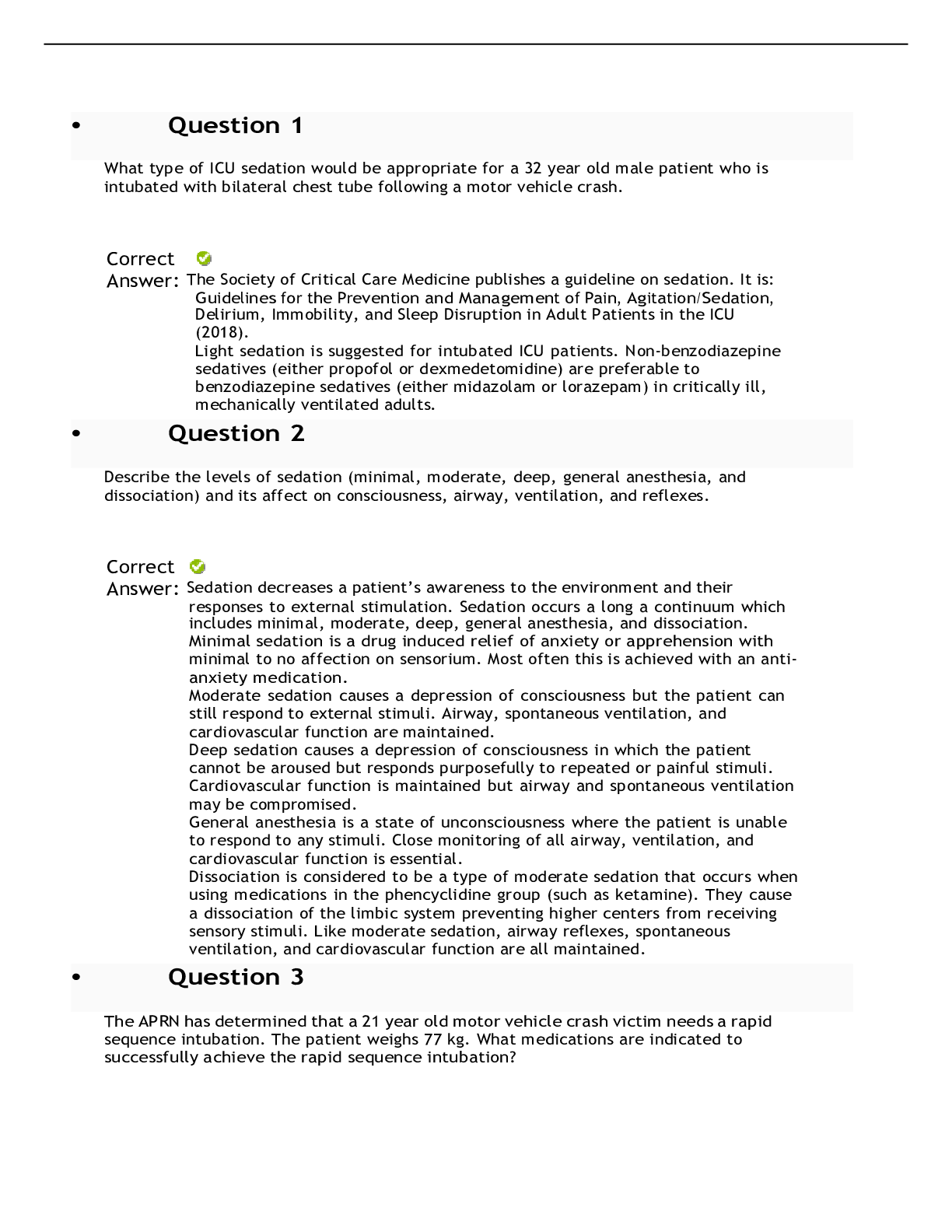
NRNP 6566 Week 8 Knowledge Check (100% Correct) Verified Answers
What type of ICU sedation would be appropriate for a 32 year old male patient who is intubated with bilateral chest tube following a motor vehicle crash. Correct Answer: The Society of Critical...
By Nutmegs
QUESTIONS & ANSWERS
$7
0
*NURSING> QUESTIONS & ANSWERS > NRNP 6566 Week 9 Knowledge Check (100% Correct) Verified Answers (All)
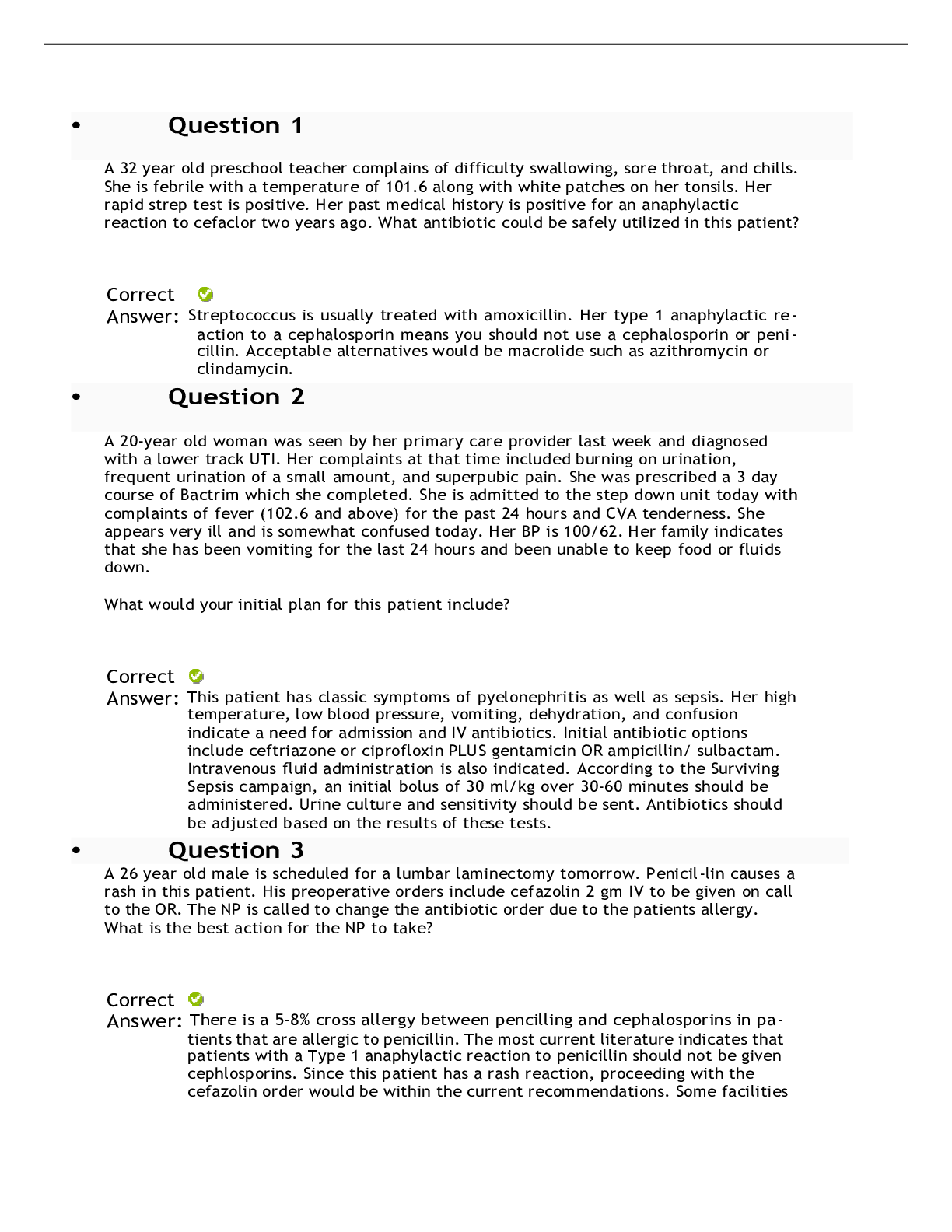
NRNP 6566 Week 9 Knowledge Check (100% Correct) Verified Answers
A 32 year old preschool teacher complains of difficulty swallowing, sore throat, and chills. She is febrile with a temperature of 101.6 along with white patches on her tonsils. Her rapid strep test is...
By Nutmegs
QUESTIONS & ANSWERS
$7
0
*NURSING> QUESTIONS & ANSWERS > NRNP 6566 Week 11 Knowledge Check (100% Correct) Verified Answers (All)
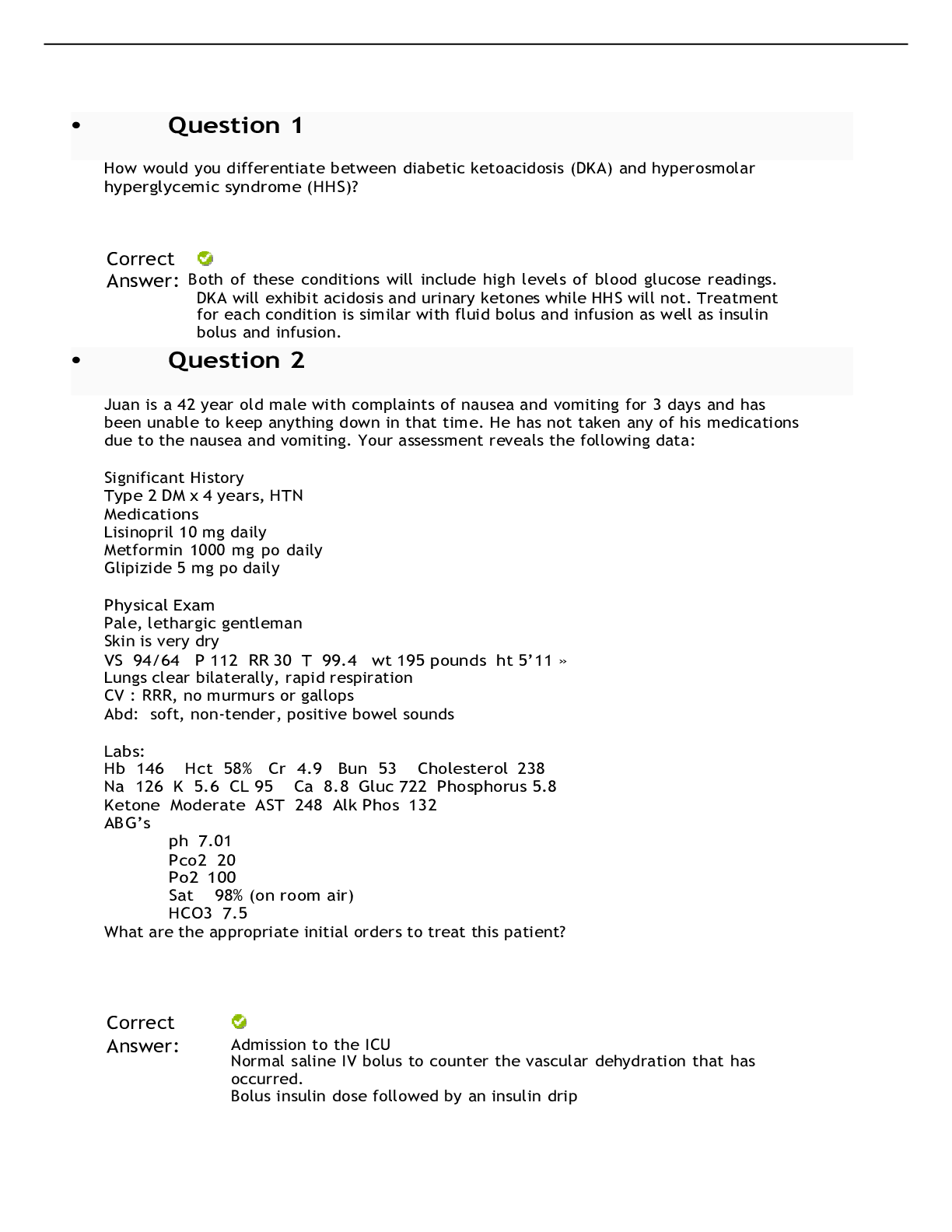
NRNP 6566 Week 11 Knowledge Check (100% Correct) Verified Answers
How would you differentiate between diabetic ketoacidosis (DKA) and hyperosmolar hyperglycemic syndrome (HHS)? Correct Answer: Both of these conditions will include high levels of blood glucose...
By Nutmegs
QUESTIONS & ANSWERS
$8
1
*NURSING> QUESTIONS & ANSWERS > NRNP 6566 Week 10 Knowledge Check (100% Correct) Verified Answers (All)

NRNP 6566 Week 10 Knowledge Check (100% Correct) Verified Answers
WEEK 10 QUESTION 1 Describe the different etiology of pre-renal, intra-renal, and post-renal acute kidney injury and provide examples of clinical conditions that cause each. Pre-Renal: Would be any...
By Nutmegs
QUESTIONS & ANSWERS
$8
0
Reviews( 0 )
More information
Uploaded On
Nov 18, 2021
Language
English
Type
Bundle
Number of Documents:
9





